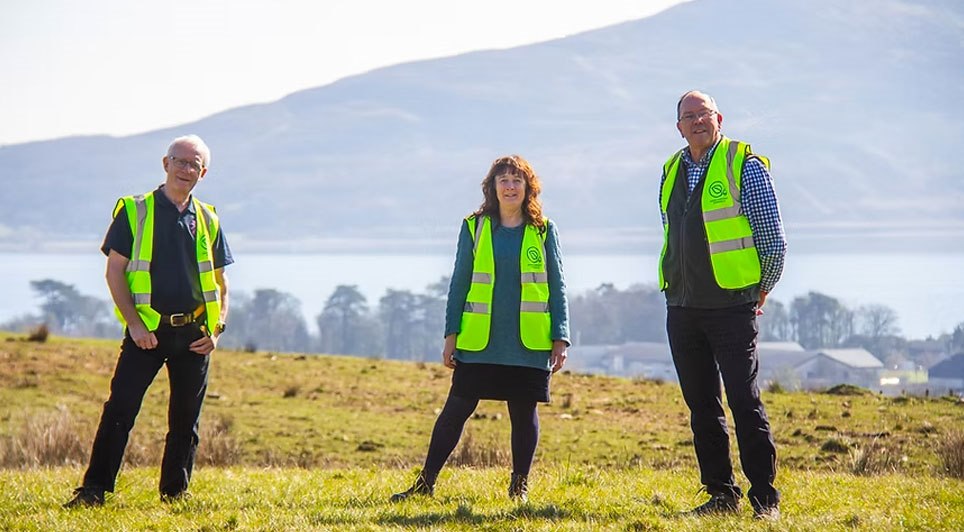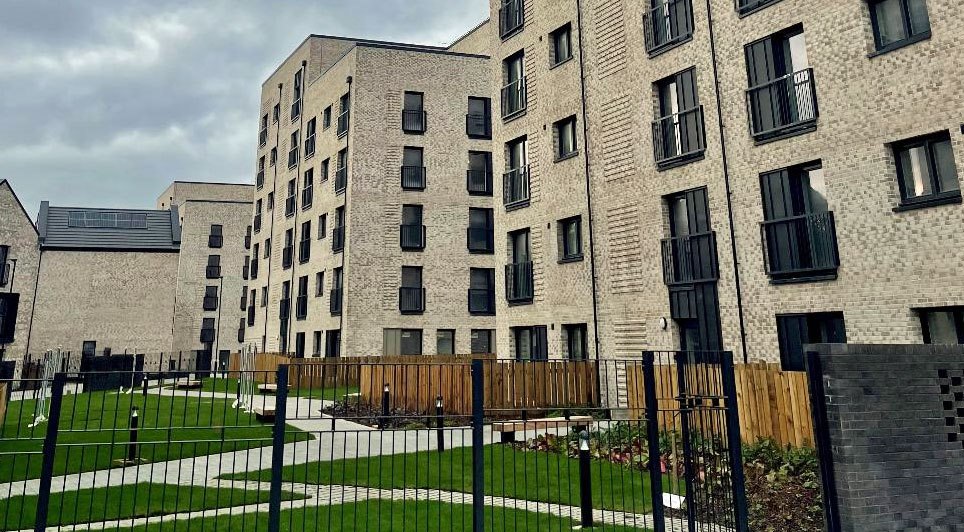Following a recent trial at the Bogendollo House in Aberdeenshire, an innovative method was successfully used to insulate an internally-lined solid masonry wall without causing damage to the historic features of the wall.
The method involved using water blown foam, developed by Canadian company Icynene Inc. This is the first time such insulation has been used in an historic building in Scotland. The water blown foam was created specifically for injecting into delicate structures. The foam expands slowly putting little pressure on the fragile inner wall and, as it is 100 percent water blown, it contains no harmful blowing agents. Additionally, through its open cell structure, the foam will allow the wall to breathe which will assist in controlling moisture movement.
Dr. Amar Bennadji, Principle Investigator of the project and lecturer in Architectural Technology at Robert Gordon University (RGU) Aberdeen stated that "following the successful trial, the heat loss through the wall was reduced by approximately 50 per cent". He explained that "this project opens the door for historic buildings to finally retain warmth, reduce their energy bills and contribute to efforts to curb global warming by reducing their carbon footprint." He further added that "the project team aims to pursue further work to improve historic building components, such as solid floors and sash windows."
Jeff Hood, Icynene's Vice-President flew in from Canada to Scotland to witness the trials. He said: "as a pioneer of the Green Building movement Icynene has developed non-destructive techniques of insulation that have been successfully used in historic buildings in North America for a number of years". He added that "We were very keen to observe and advise on the first test of this technology in the UK as until now there wasn’t a procedure available which could be used to insulate internally-lined solid masonry walls. The performance of the wall will be observed and monitored over the coming months."
"The success of this trial is highly significant for owners of historic houses and indeed registered social landlords who also have old housing stock with cavity walls," said Simon Falkner-Lee, Icynene's UK-based spokesperson. He explained that "the trial shows conclusively that Icynene's insulation system can be introduced into the wall cavity enabling our old and our historic houses to retain their heat whilst fully preserving their original features."
The technique called for a bead of Icynene's quick drying spray foam to seal the cavity along the bottom of the wall. Once this cavity was closed off, the pour foam was carefully injected from the attic area above.
"The success of this insulation trial has significant implications given that there are more than 400,000 historic listed buildings throughout the UK which, under new European regulations, are required to be insulated in order to make energy and carbon savings," added Mr Falkner-Lee.
The trial was carried-out through a project that was funded by the European Regional Development Fund and the SEEKIT programme of the Scottish Government under the Construction Improvement Club (CIC) scheme. The project was completed in collaboration with Craigie Levie (Architect and lecturer at RGU) and Dr Mohamed Abdel-Wahab (lecturer in Construction Management and Technology at Heriot-Watt University in Edinburgh).
The project is multi-disciplinary as it is not only limited to testing an innovative method for cavity wall insulation, but also it captures the implications for skills development and training. The insulation was installed by Kishorn Developments, an Icynene approved installer, supported by the Scottish distributor - GMS Renewable Products.
Dr. Abdel-Wahab said "this multi-disciplinary project presents a unique opportunity for providing actual project-based information on the skills requirements for successful wall insulation in historic buildings". He explained that "such information is crucial for providing guidance to government skills policy in support of the retrofitting of historic buildings."
The house owners, Mr and Mrs. Gibbons-Wood, are pleased with the project outcomes so far. Mr Gibbons-Wood said "I am hoping for the long-term success of the project and to insulate the whole house whilst maintaining its original features. I am reluctant to commit anymore investment in renewable energy without an insulated house."
(JG/BMcC)
Construction News
17/10/2011
Innovative Method Successfully Used To Insulate Historic House

15/04/2025
Construction of a £70 million student accommodation development at 292-298 St Vincent Street in Glasgow has reached a significant milestone, with the building now visibly rising from the ground.
Drone footage has captured the progress of the project, which is a partnership between developer Artisa

15/04/2025
Energy regulator Ofgem is expected to confirm today (April 15) its finalised Connections Reform process, designed to expedite grid connections for renewable energy projects that are ready and crucial for achieving the UK's clean power targets for 2030 and beyond.
The new connections system, anticip

15/04/2025
The ambitious transformation of Glasgow’s landmark George Square has moved into a tangible phase with the commencement of the erection of hoardings around the perimeter of the civic space. Starting today, the hoardings will enclose the Square for the duration of its 18-month redevelopment.
The pane

15/04/2025
Members of the public are invited to attend a consultation feedback event to discuss the proposed infrastructure associated with a new underground electricity transmission cable between the Kinardochy and Errochty substations in Perthshire.
The event will take place on Monday, 28 April, from 4 pm t

15/04/2025
Turner & Townsend have been appointed as project managers to develop a business case for the potential extension of the Borders Railway beyond its current terminus at Tweedbank to Hawick and Carlisle.
This key appointment will enable crucial work to progress on the project, including feasibility s

15/04/2025
Arran Community Renewables, a Community Benefit Society based on the Isle of Arran, has secured planning consent for a 6 MW solar farm. The Glenkiln Solar Farm, located approximately 1km west of Lamlash, is projected to generate 5,600MWh of clean renewable energy annually from 2027.
The £5 million

15/04/2025
A new Route Map has been published by the Scottish Land Commission (SLC) to ensure communities across Scotland secure tangible and long-lasting benefits from nature restoration projects and investment in the country's natural environment.
The practical guide is designed for landowners, developers,

15/04/2025
Award-winning principal contractor Procast Group has further expanded its presence across Scotland with the opening of a new base in Dumfries. The Hamilton-based firm has invested £30,000 in a new warehouse and office facility in the Maxwelltown Industrial Estate in Dumfries and Galloway, marking it

14/04/2025
Glasgow City Council's Affordable Housing Supply Programme (AHSP) facilitated the completion of over 1,000 new affordable homes in the city during the past year, despite facing budgetary reductions at the start of the financial year.
The initial grant of £78.687 million from the Scottish Government

14/04/2025
A key phase of Scottish Water's £11.5 million project to upgrade a strategic rising sewer main connecting Renfrew and Glasgow is set to begin, resulting in a significant road closure.
From Monday, 28 April 2025, Ferry Road in Renfrew will be closed to all vehicular traffic for a period of four mont
 Scotland
Scotland UK
UK Ireland
Ireland London
London











